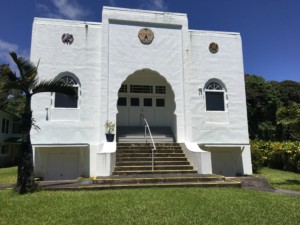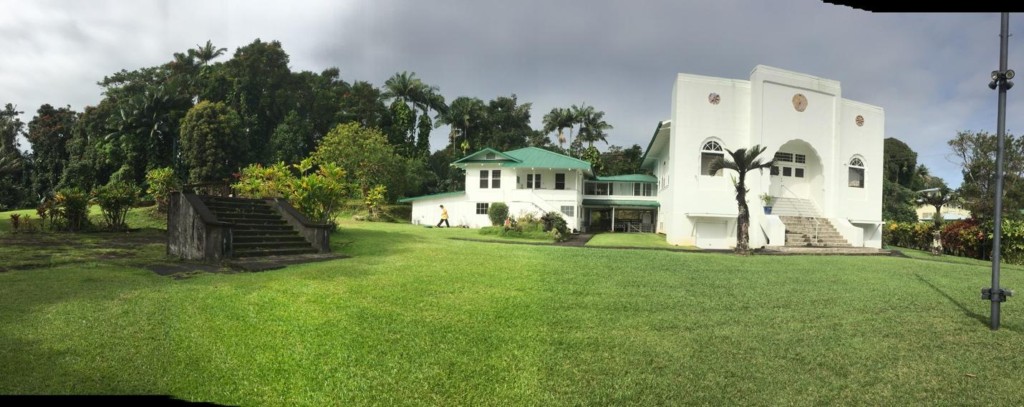Historic Hawai‘i Foundation’s executive director and education program manager enjoyed a site visit to the Hakalau Jodo Mission, perched on the stunning Hamakua Coast on Hawai‘i Island, on Kamehameha Day 2019 while on island for HHF’s annual preservation seminars co-hosted by the National Park Service. Community engagement and ongoing stewardship of this beautiful and significant historic place is notable and inspiring. An upcoming presentation on the history and meaning of Obon and Bon Dance lent an air of great excitement and a multitude of other activities and events such as yoga, farmers market and senior luncheons help introduce new members and local community to the rich history of the Mission and plantation era.
The Mission received a preservation grant through Historic Hawai‘i Foundation in 2018 that will help repair leaks and water damage in the temple and social hall; restore the decorative medallions on the temple facade; repair windows and doors and install safety barriers at the remains of the former language school. 
Community member and Mission steward, Susan Forbes, DrPH, who co-authored the Historic Register nomination with architectural historian Don Hibbard, PhD, gave HHF a tour and shares more below about the preservation of the Mission and what makes Hakalau unique.
Historic Hawai‘i Foundation: What were some of the threats that this area or property faced?
Susan Forbes: Hakalau Jodo Mission has a small, aging membership. Sustainability is a challenge. Fortunately, the Mission is viewed as an important part of the community.
The threat is being viewed as irrelevant in a changing environment. The Hakalau Jodo Mission works hard to remain relevant by engaging the community as well as other Buddhist sects.
HHF: What was most needed to preserve the Hakalau Jodo Mission?
SF: There are two areas most needed to preserve the Hakalau Jodo Mission. One relates to the immediate preservation projects such as identifying and plugging leaks, repairing leak damage, repairing windows and screens, and interior painting, (Of course, there are other preservation projects in the wings, awaiting completion of the current round of projects!) The second area relates to expanding community engagement with the Mission. One of the stated purposes of the Hakalau Jodo Mission is “the promotion of happiness among the members and the community”. Right now, the Mission serves its members and supports the broader community as a meeting place. The Hakalau Plantation Village Association and the Hakalau Neighborhood Watch both hold meetings there. Senior Luncheons for various groups in East Hawaii are held 3 times a month in the community dining room. Yoga and bon dances classes are held on a regular basis. WE CAN DO more to connect with the broader community to share cultural traditions and promote happiness.
HHF: From your website, I see that the Hakalau Jodo Mission has a history of community engagement as well as bringing together a mixture of people, cultures, traditions, religious beliefs, values, and so much more. That’s such a beautiful sentiment, especially in current times. Can you touch upon what these values mean to you and Hawai‘i as a whole?
SF: I can certainly address what these values mean to me based on what I’ve experienced in Hakalau. This area has undergone a dramatic demographic shift since the demise of the sugar industry and subsequent sell-off of cane lands. Newcomers arrive and settle here from many other states and countries. The cultural values from the plantation and from Japanese Buddhism both have lessons that support a more peaceful, happier social environment, values that draw people to work together.
I learned about these values through experience. Akiko Masuda, of Akiko’s Buddhist Bed and Breakfast and President of the Wailea Village Historic Preservation Community, introduced me and my husband to the Hakalau Jodo Mission and its members as well as former residents attending the Hakalau School and Community Reunion. These individuals grew up on Hakalau Plantation from the 1930s-1960s.
Former residents share a love of Hakalau and work diligently to share pictures, stories and maps to reinforce their memories. Ken and I learned a lot from these folks and, gladly, have maintained contact with many. The key lesson was that culture can be passed from one time to another and one group to another. The values from the shared are gifts to us:
• Engage in collective effort
• Look out for each other
• Honor hard work
• Show respect for those who came before us
Now, we work with others at the Hakalau Jodo Mission and in the community to share these values.
HHF: What do you feel is the most special aspect of the Hakalau Jodo Mission and why does it hold a special place in not only your heart, but the communities?
SF: The answer is simple. The Hakalau Jodo Mission is a place of peace and happiness.

The Hakalau Jodo Mission, of Japanese Buddhism’s Jōdo-shū sect, follows the Pure Land Teachings of Honen. The current Mission, built and dedicated in 1936, is on one acre of land provided by the Hakalau Plantation in Hakalau Upper Camp (aka Up Camp). Formerly at the site was a two story Japanese Language School and Church. Hakalau Jodo Mission was added to the Hawai‘i State Register of Historic Places in August of 2018.
The Mission is significant for its architectural style and its association with historical events. It is a good example of an East-West Buddhist temple built in Hawai‘i during the 1930s. Rendered in an East-West style that incorporates, renaissance, Mughal and Japanese elements, it features a centered, scalloped, round arched entry which is flanked by scalloped round arched windows to either side. The Mission is associated with the development of Buddhism on the island of Hawai‘i, and with the role of the Japanese in Hawaii’s history. Between 1936-1968 the Mission and surrounding community experienced economic prosperity then decline with the dissolution of the sugar industry. World War II’s social and cultural impact followed with a period of major upheaval from 1960-1968 when the plantation camps were dismantled and the Mission membership declined as members moved to other communities.


